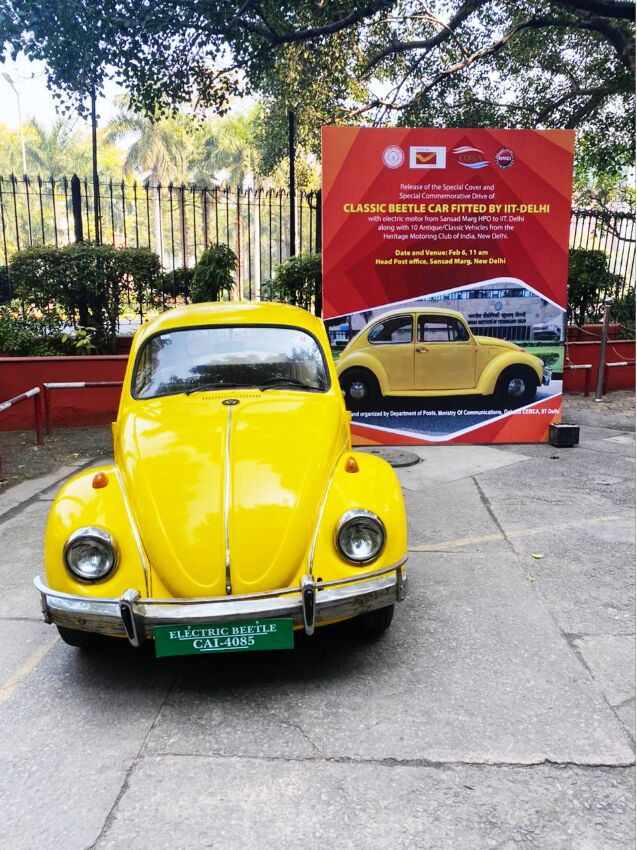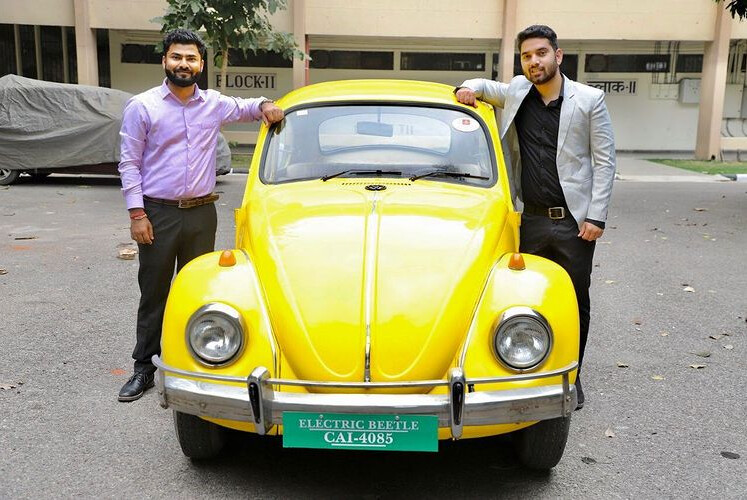Three years ago, when the Delhi-NCR region was in the midst of another intense smog, Major (Retd) Manjit Rajain was deeply concerned about his granddaughter, who was living there. As the chairman of Tenon Group, a leading integrated facility management, security services and remote monitoring solutions provider based out of Gurugram, Manjit realised he needed to do his part to ensure his granddaughter grows up in a healthier environment.
(Image above of Maj Manjit Rajain standing next to his 1948 Volkswagen Beetle, which was converted into an EV.)
“The smog was so thick that you couldn’t even see a building across the road. Thinking about what I could do to ensure my granddaughter grows up in a healthier environment, I began thinking about how I could go green. For example, we made sure that our new corporate headquarters in Gurugram was a green building utilising maximum natural light and minimising electricity use. However, a real turning point came when I met a dear friend, Mr Arun Duggal, the former Chief Executive of Bank of America in India, and we began discussing my vintage car collection,” says Manjit, speaking to The Better India.
During their conversation, Manjit recalls how Arun spoke of enjoying vintage cars, but was concerned about the amount of pollution they emitted.
“Arun wanted to drive a vintage car without feeling guilty of polluting the atmosphere. That’s when I asked him to reach out to IIT-Delhi, where he had founded the Centre of Excellence for Research on Clear Air (CERCA), and told him that I would give away one of my vintage cars if they could convert it into an electric vehicle. In February 2020, I gifted away my classic 1948 Volkswagen Beetle to IIT-Delhi for conversion,” recalls Manjit.
By February 2021, his vintage 1948 Volkswagen Beetle became India’s first classic car to be converted into an Electric Vehicle with zero polluting exhaust emission. According to the Vintage and Classic Car Club of India (VCCCI), cars manufactured after 1940 but before 1970 are categorised as classic cars. Meanwhile, the most widely recognised definition for vintage cars is a car which was manufactured between 1919 and 1930, notes this explainer.
Work on the conversion process was done by Mohammed Jawaad Khan, an engineer from Bhaderwah in Jammu’s Doda district. He worked on the project at CERCA. Jawaad is also the founder of a startup called Tadpole Projects, which is engaged in the process of converting IC-engine vehicles into electric ones.
Besides gifting his car for the project, Manjit bought the parts required for the conversion process like the battery pack, converter and other materials from the open market. He gave those parts to Jawaad, who did the retrofitting work. The whole venture cost Manjit Rs 4 lakh.

The Conversion Process
Although the project was scheduled for completion within six weeks, COVID-19 brought a screeching halt to the proceedings. Jawaad had already drawn out the entire design on paper.
“As a result of COVID-19, we couldn’t do road trials and take it to mechanics for additional work like reinforcing the floorboard to help carry the weight of the battery pack. For nearly six months, everything was shut down. But when work re-commenced on the project, the first component Jawaad removed was the engine. In fact, that engine is now sitting in my garage. I couldn’t do away with it because this is a vintage,” says Manjit.
The Beetle is a unique car in that it has an engine in the boot at the back. What Jawaad did was replace its engine with an electric motor. This is a powerful motor because it can drive the Beetle upto 60 kmph or more. His team also connected the electrical motor to the rear wheel drive of the car.
“We also needed a big battery pack since it needed enough juice to last it for a reasonable distance. The front trunk of the car was entirely taken up by the battery pack, which also includes a converter that converts the electrical power to mechanical power. The vehicle also has a unique self-recharging property. The electric version does not have multiple gears but instead has only two — forward and reverse. I have driven this car at over 60 kmph, although that’s the optimum speed for the 50-70 km battery range. We can raise the range to 100 km by either driving it at slower speeds or adding more batteries” says Manjit.
Leaving 90 per cent of the 1948 Volkswagen Beetle untouched, a 15 KW electric motor and 120 AH lithium-ion battery were attached. It typically takes six hours to charge the car, but with a fast charging system, it can be done in three.
Speaking to the Kashmir Monitor, Jawaad said, “The mileage goes around 50/70km as it can be increased by adding more batteries. The AC charging takes 6-7 hours and the DC charging system takes 40-50 min. It can also be controlled through the phone by using a Bluetooth dongle. The car is working with a full-on manual gear system as it produces more torque, speed, and efficiency. About 90% of car parts are original.”
Jawaad went on to add, “It has a Bluetooth dongle with the help of which, features like temperature of motor, battery input power, peak current and rpm and any errors in the kit can be monitored and controlled using a mobile phone.” More than 70 per cent of the components were bought from India with only the controllers imported.

Conversion at a Cost
Speaking to The Better India, Manjit says, “We also re-painted the car and put in new seats. The conversion process came to an end in November and there were no technical problems during trials. My only regret was that if I had invested another Rs 1 lakh, I would have built a bigger battery pack that could run it for 200-300 km on a single charge. The next classic car I convert will have a bigger battery pack. After the process concluded, many vintage and classic car owners called me to help them convert their vehicles into electrical.”
To commemorate the successful launch of the first classic retrofit electric car on 6 February 2021, a special cover and postmark were released at Head Post Office, New Delhi.
Having said that, this launch came at a cost as well. Technically, the moment the engine was removed from Manjit’s 1948 Volkswagen Beetle and replaced with an electric motor and battery pack, it no longer counts as a vintage or classic car. In a typical vintage car, every part has to be original, and that’s how these vehicles are judged by automobile aficionados.
“Moreover, these cars are very rare and expensive in India. You’d be surprised how many people have vintage cars that don’t run. Personally, I feel you should be able to at least take them out for a spin on the road. How do we make these cars usable and help them survive? I believe we have shown the way,” Manjit says, adding, “Imagine a decade where these vintage and classic cars run on concrete roads with their flawless beauty and don’t cause even 1 per cent pollution. I’m confident that we will get to see many more such cars in their electric avatars. If I can give away this very rare and expensive car to convert it into an electric vehicle, I’m sure other car owners can, too. Besides preservation, the conversion of vintage into EV offers sterling opportunities for the country, economy and the environment.”
(Edited by Yoshita Rao)
No comments:
Post a Comment